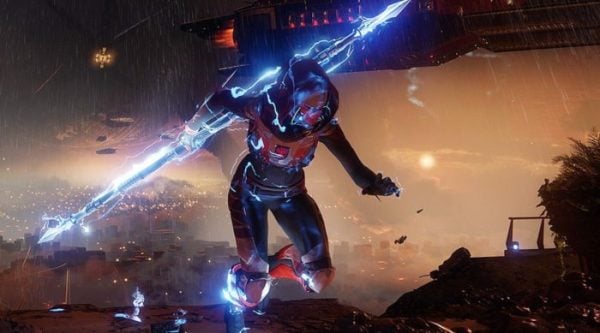Read the Modifiers
If you’re a Destiny 1 veteran who has jumped into Destiny 2 for some more punishment, then this may come as a no brainer. But for newcomers, Nightfall modifiers are what really define each week’s challenge. They change every week and are locked in until the refresh, so it’s important to get a good handle on them and learn them as you put in more time into the game.
They’re crucial because they decide how you need to play. For instance, week one of Destiny 2 offered Prism and Timewarp: Killing Time. Prism rotates the focused element, meaning a particular burn will be powered up every so often, while all others are weakened (requiring serious coordination). Killing Time means you only earn time back if you kill an enemy. This promotes a more aggressive playing style.
Knowing is half the battle, so don’t forget to read.
Coordinate Subclasses (Also, One Bangs Aren’t the Most Useful)
The classes you and your fireteam choose to take into a Destiny 2 Nightfall Strike are very important. Depending on the active modifiers they can either make you a killing machine or a complete liability. This is why it’s important to coordinate with your team members to make sure you are all getting the most bang for your buck when it comes to raw power.
Unless there’s one specific focused burn (Solar, Arc, or Void) I’d recommend everyone in your fireteam going with one each. Nightfall tends to change the regular shield elements that you would’ve seen elsewhere, so you can’t trust that information. It’s good to be prepared for anything. Also, when it comes to supers, one bangs (what I like to call Void Bomb or a Golden Gun with Celestial Nighthawk) are not as useful as those that last a period of time (Like Transcendence or Hammer of Sol). The longer lasting super abilities in Destiny 2 can cover more ground and generate more orbs, plus there’s a lower chance to miss. Sure, the one bangs can do serious damage to a boss, but you need to hit, and you only get one shot.
Coordinate Loadouts While You’re At It
Your weaponry is just as important as your subclass in Destiny 2. There are a lot of different weapon types available, ranging from small personal sidearms to powerful rocket launchers. When moving as a team, you want to make sure that you all have as many options available as possible.
During a Nightfall Strike, it’s good to bring things like Snipers, Fusion Rifles, and Auto Rifles for burning down enemies quickly. A good exotic in just about any situation is the Coldheart (especially if more than one person has it), and Shotguns make short work of enemies in tight spaces. There’s a large selection of amazing exotic and legendary weapons to choose from, so take your pick and mix and match it up.
Supers Are Best Used to Create More Supers
It can be really tempting to use a super ability in Destiny 2 for the sole purpose of taking down a single powerful enemy. Maybe they’re being annoying, or perhaps you’re just impatient. But if you get the kill you may generate three Orbs of Light if you’re lucky. If nobody else on your team has their super, you will find yourself in a very tight spot if you run into a group of minions during the Nightfall Strike.
If you must use your super on a boss or other powerful enemy, we suggest waiting until it summons some adds. That way your other fireteam members can get a quick charge to help take out the boss, or clear out the next area. By using your most powerful ability in this way, it allows a near endless cycle of your team just being powerful badesses. And who doesn’t want to be a powerful badass?
Watch the Clock
If you haven’t tried a Nightfall Strike in Destiny 2 just yet, you may be surprised to find out that they’re now timed. Each strike has a different time limit, but rest assured that whatever it is will keep you on your toes and dial the tension up to 11. This is not timed in the way like they became in Destiny 1 either, where you had 30 minutes to earn bonus rewards and complete a bounty. Instead, the clock (which is much shorter than 30 minutes) is constantly ticking towards zero, offering a specific way to extend it (such as earning two seconds for killing an enemy). But once it does run out, you’re done. The game boots you back to orbit, forcing you to start again.
To help with the clock, you can’t wipe anymore (for those new to Destiny, a wipe is when all members of your fireteam die and you have to restart a section). However, the clock never stops ticking, so being dead is still a huge liability. The only true way to fail a Nightfall Strike in Destiny 2, though, is to not beat the clock, so it is your greatest adversary. Never take your eyes off of that clock. Call it out at intervals, let your team know whenever a minute has passed, or every 30 seconds when you’re down to crunch time. Do not stop fighting until the very end.
Train in Vanguard Strike Playlist
Yes, when running a Nightfall Strike in Destiny 2 certain aspects of the chosen strike are changed. Some examples are the enemy types in certain posts, and the shield elements, as well as the overall power level of the enemies you’ll confront. However, the core of the strike does not change at all. Each objective is the same, so if you already know how the strike works at a core level, then the only challenge you really have is dealing with the enemies.
It’s a very good idea to run through the strikes in Destiny 2’s Vanguard Strike Playlist. You’ll get ample practice and learn the ins and outs of each boss on offer. This way you can come up with different strategies for each encounter as well, so you’re always prepared.
These tips should have you completing Nightfall Strikes in no time. If you have any other questions about Destiny 2, be sure to check out our constantly expanding wiki.





